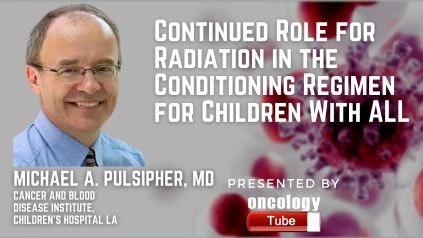Michael A. Pulsipher, MD from the Cancer and Blood Disease Institute, Children’s Hospital Los Angeles discusses Continued Role for Radiation in the Conditioning Regimen for Children With ALL.
Link To Full Article:
https://ascopubs.org/doi/full/10.1200/JCO.20.03261
The outcomes of the 413 randomly selected patients showed an unequivocal increase in survival using the TBI method. A startling 28 percent (86 percent v 58 percent; P < .0001) of event-free survival (EFS) was higher at 2 years. For a population where the advantage was not apparent and did not work, the authors looked very hard. CR1 patients had an EFS gain of 24 percent (91 percent v 67 percent; P < .001), and CR2 patients had an increase of 30 percent (74 percent v 46 percent; P = .002). Patients with a lower risk of late relapsing CR2 had a 20% advantage (89% v 69%) and patients with high-risk cytogenetics had a 29% advantage (89% v 60%; P = .02) (BCR-ABL+, KMT2A-AFF1 translocation, hypodiploidy [< 45 chromosomes]). In these outcomes, relapse was the driving force, with TBI showing a strong benefit (2-year cumulative relapse occurrence, 12% v 33%; P < .001). In multivariate study, increased overall survival (OS), EFS, and relapse with TBI all retained importance. In both arms, TRM was low, but in the TBI arm, it was surprisingly low (2% v 9% at 2 years; P = .03).
One interesting finding in this study is that for either univariate or multivariate analysis, pre-HCT MRD did not seem to factor into survival outcomes. This is surprising considering how increasing relapse and worse survival have consistently been correlated with the existence of pre-HCT MRD.12,13 One might conclude that MRD-negative patients will have a lower risk of relapse, and thus, with this category, TBI will be less essential. However, this was not the case, possibly due to aggressive approaches taken by the investigators to achieve deep pre-HCT remission using chemotherapy and immunotherapy (blinatumomab or inotuzumab). Flow cytometry MRD rates > 0.01 percent were very low, and while there was a 32 percent incidence of pre-HCT MRD > 10-4 when PCR-based MRD was used, recent international analyses showed similar findings for patients between 10-3 and 10-4,14 the patients’ MRD level before HCT in this study. In addition, the protocol required early weaning parameters closely matching post-HCT chimerism and MRD, potentially raising the graft versus leukemia effect’s ability to resolve low MRD levels. A more detailed review is underway of the MRD technique used in this trial and the subsequent effects.
So does this mean that the HCT culture as the quality of treatment is forever chained to TBI? It definitely suggests that a TBI-based preparative regimen is actually the preferred treatment without a very sound reason to deviate. TBI-based interventions are also likely to lead to less relapse for children aged 3 and younger,15 who were excluded from this study due to concerns about the age-related impact of TBI on neurocognitive growth and other late outcomes.16,17 Exclusion from TBI-based approaches of these youngest children is standard practice and speaks to the need for similarly successful non-TBI alternatives. Notably, there are currently methods under review that can identify patients who do not need TBI for high cure rates. In patients who are in very deep remissions, the Pediatric Transplantation and Cellular Therapy Consortium (PTCTC) is researching non-TBI approaches (next-generation sequence-MRD negative, no detectable responsive cells up to 10-6 or 10-7; the EndRAD study). The rationale for this approach is based on extremely low relapse rates found in this lower-risk population (95% EFS) in a sub-analysis of an earlier COG study.18,19 Data from the KIR-favorable haploidentical HCT phase II multicenter PTCTC study showed outstanding survival with rating, fludarabine, thiotepa, melphalan reduced-toxicity approach, resulting in statistically better EFS and better haploidentical HCT (Abdel-Azim et al, abstract submitted for publication).

